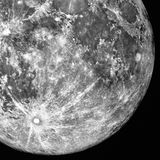
This weekend is a fine time to take a tour of the lunar surface, from its once molten seas to its vast craters and mountain ranges. You won't want to miss Sinus Medii, Montes Apennius and the lunar club challenge, Sinus Aestuum.
Friday, October 11 - Tonight our lunar mission is to identify Mare Vaporum - "The Sea of Vapors" - on the southwest shore of Mare Serenitatis. Formed from newer lava flow inside an old crater, this lunar sea is edged to its north by the mighty Apennine Mountains. On its northeastern edge, look for the now washed-out Haemus Mountains. Can you see where lava flow has reached them? This lava has come from different time periods and the slightly different colorations are easy to spot even with binoculars.
Further south and edged by the terminator, or the line of light and shadow, is Sinus Medii - the "Bay in the Middle" of the visible lunar surface. Located centrally on the terminator, and the adopted "center" of the lunar disc, this is the point from which latitude and longitude are measured. While the smooth plain may look small, it covers about as much area as the states of Massachusetts and Connecticut combined. During full daylight temperatures in Sinus Medii can reach up to 212 degrees!

Surveyor 6 on the plains of Sinus Medii - Credit: NASA/Goddard/Arizona State University
On a curious note, in 1930 Sinus Medii was chosen by Edison Petitt and Seth Nicholson for a surface temperature measurement at Full Moon, by measuring infrared radiation. Experiments of this type were started by Lord Rosse as early as 1868, but on this occasion Petit and Nicholson found the surface to be slightly warmer than boiling water. Around a hundred years after Rosse's attempt, Surveyor 6 successfully landed in Sinus Medii on November 9, 1967, and became the very first probe to "lift off" from the lunar surface.
Saturday, October 12 - Let's begin our lunar studies tonight with a deeper look at the "Sea of Rains" or Mare Imbrium. Our mission is to explore the disclosure of Mare Imbrium, home to Apollo 15. Stretching out 1123 kilometers over the Moon's northwest quadrant, Imbrium was formed around 38 million years ago when a huge object impacted the lunar surface creating a gigantic basin.
The basin itself is surrounded by three concentric rings of mountains. The most distant ring reaches a diameter of 1300 kilometers and involves the Montes Carpatus to the south, the Montes Apennius southwest, and the Caucasus to the east. The central ring is formed by the Montes Alpes, and the innermost has long been lost except for a few low hills which still show their 600 kilometer diameter pattern through the eons of lava flow.

Apennine Mountains by Tammy Plotner
Originally, the impact basin was believed to be as much as 100 kilometers deep. So devastating was the event that a Moon-wide series of fault lines appeared as the massive strike shattered the lunar lithosphere. Imbrium is also home to a huge mascon (a region below the lunar sea that is so dense it perturbs spacecraft in lunar orbit), and images of the far side show areas opposite the basin where seismic waves traveled through the interior and shaped its landscape!
The floor of the basin rebounded from the cataclysm and filled in to a depth of around 12 kilometers. Over time, lava flow and regolith added another five kilometers of material, yet evidence remains of the ejecta which was flung more than 800 kilometers away, carving long runnels through the landscape.
Sunday, October 13 - Tonight let's discover our own Moon as we take a look at Mare Insularum, the "Sea Of Islands." It will be partially revealed tonight as one of the most prominent of lunar craters, Copernicus, guides the way. While only a small section of this reasonably young mare is now visible southwest of Copernicus, the lighting will be just right to spot its many different colored lava flows. To the northeast is a lunar club challenge: Sinus Aestuum.

Sinus Aestuum Region - Credit: LRO/NASA
Latin for the Bay of Billows, this mare-like region has an approximate diameter of 290 kilometers, and its total area is about the size of the state of New Hampshire. Containing almost no features, this area is low albedo and provides very little surface reflectivity. Can you see any of Copernicus' splash rays beginning to appear yet?
What is your favorite lunar feature? Let us know in the comments!
Until next week? Ask for the Moon, but keep on reaching for the stars!
About Tammy Plotner - Tammy is a professional astronomy author, President Emeritus of Warren Rupp Observatory and retired Astronomical League Executive Secretary. She's received a vast number of astronomy achievement and observing awards, including the Great Lakes Astronomy Achievement Award, RG Wright Service Award and the first woman astronomer to achieve Comet Hunter's Gold Status.

















